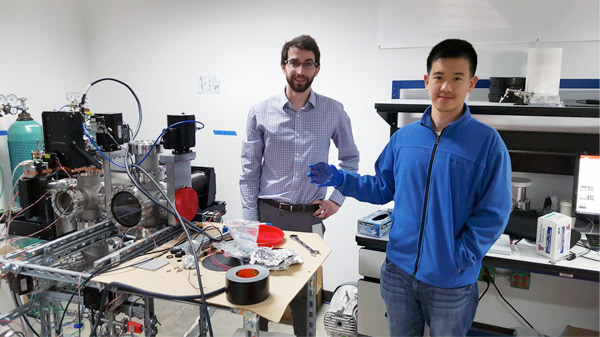Startup Founded by Pair of Hertz Fellows Charges beyond Steam-Powered Electricity
As co-founders of the Seattle-area startup, Modern Electron, Hertz Fellows Tony Pan and Max Mankin have an ambitious goal: to fundamentally change the way the world generates electricity.
Taking a page from advances in semiconductor technology, the two scientists and entrepreneurs want to overturn more than a century of electricity generation via steam turbines using paper-thin, nano-engineered generators, enabling more efficient, cheaper, and more universally available power generation than ever possible before.
“Steam turbines have dominated electricity generation for a long time, but they do not scale down to mobile applications or local power generation because fundamentally, they are very large fan blades,” explained Mankin, Modern Electron’s Chief Technology Officer. “We are using microfabrication to make compact heat engines that have no moving parts and extremely high power density. Most importantly, they are quite scalable.”
Mankin and Pan, who both have PhDs from Harvard, founded the company in November and have raised more than $10 million from investors. They are currently building prototypes of their modular devices, which use heat to move electrons to a higher voltage. The technology, Pan said, should enable a completely different form and scale of electrical generation that is not only much smaller, but can outperform a traditional steam turbine in a head-to-head comparison.
“One thing we’re ultimately aiming for is efficiency,” said Pan, the company’s CEO. “Whether it is burning a fuel like coal or a more modern high technology such as nuclear, at the end of the day you’re generating heat to boil water and turn fan blades. Steam turbines throw away a lot of energy because they simply can’t operate at higher temperatures. But it turns out for our device, we can utilize much hotter intrinsic flame temperatures of most fuels and access much higher efficiencies.”
Mankin and Pan’s collaboration is directly tied to the Hertz Foundation. In 2011, after the second year of his PhD program, Pan thought about branching out to energy and came into contact with the Invention Science Fund in Bellevue, Washington, an incubator within Intellectual Ventures, founded by Hertz Fellow Nathan Myrhvold. Pan got to work researching alternative means of turning heat into electricity, and realized he needed a co-founder with deep knowledge of chemistry, nanofabrication, materials science, and electron microscopy. He called upon Mankin, whom he had previously met at Hertz retreats.
“I was looking to work on something that could impact the world,” Mankin said. “I’m so excited about the potential of this technology to genuinely change the way the world works for the better.”
Mankin, Pan, and their small team of engineers are working full speed ahead to optimize their technology. The next couple of years, Mankin said, will be devoted to research and development, systems engineering, and scaling fabrication of the devices, which he is confident represent the future of electricity.
“One of the big driving forces in the energy industry is local generation on a smaller scale,” Mankin said. “We’ve talked to several people who’ve said ‘I wish I didn’t have to rely on the grid and I could generate down the street.’ The ability for people to be able to do that will revolutionize who has access to electricity– hopefully everyone– and push the cost of energy to new lows.”

Pan and Mankin were both named to Forbes “30 Under 30” in Science list for 2015 and 2016, respectively. While flattered by the recognition, they’re not letting the publicity get to their heads.
Pan, 30, has 30 issued patents and is a co-inventor of an additional 50 patent applications spanning areas such as energy, nanotechnology, and biomedical devices. He grew up in Taiwan, Scotland and Korea, before immigrating to the United States at 18. He earned a BS in physics at Stanford, in 2008, and moved on to Harvard, where he earned his PhD in physics researching the birth and fiery deaths of the first stars formed after the Big Bang. While he still professes an abiding love for astrophysics, Pan has shifted to a literally more down-to-earth focus: energy, where he feels he can have a more direct impact on the world.
His counterpart, Mankin, 26, grew up in Massachusetts. His father was an electrical engineer and his mother a science teacher, and young Max was constantly tinkering with electronics, chemistry sets and microscopes. As a teen, Mankin became enamored with nanotechnology, which he calls “the ultimate intersection of physics, chemistry and math.” Mankin earned a BS in chemistry from Brown University, where he researched nanomaterials and characterized how they could be used in fuel cells. At Harvard, he developed new methods of nanoscale crystal growth and assembly to tune how semiconductor nanowires absorb and emit light. He obtained his PhD in physical chemistry and has 17 patents pending to his credit.
While both men acknowledge it will probably take time to convince the energy industry to adopt a new technology, because their heat engine is so much more compact (they can be built orders of magnitude smaller than other engines with accordingly less material), the devices should eventually translate to much better economics. The potential for their technology to be more efficient than steam turbines will save on fuel costs and reduce emission, while enabling scalable generation will save money on transmission lines and central power stations. Reducing the capital cost of generation, Pan said, will have significant impacts, especially on developing nations.
“There are still more than one billion people who don’t have access to electricity at all, and even more people who don’t have access to reliable power without frequent outages,” Pan said. “When you think about what you need to get everyone in the world modern living standards, reliable baseload electricity will have to be a part of that.”
“We still have a lot to do,” he added. “But it’s exciting, and I think there’s a lot of promise.”